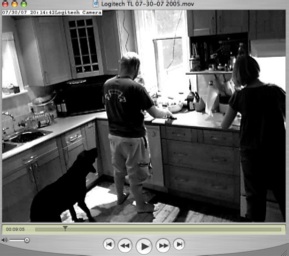Show me, don’t tell me: That’s what I thought as I glanced through the latest survey from the International Food Information Council (IFIC) Foundation on May 14, 2008.
The survey of 1,000 American adults, conducted in February and March of 2008, found that,
.jpg) "while more than three-quarters of Americans (82%) say they are confident in their ability to safely prepare food, many do not take steps to reduce the spread of bacteria in their kitchen. For instance, less than half (48%) report using separate cutting boards for raw meat or poultry and produce, and just 29% say they use a meat thermometer. … Most (92%) report washing their hands with soap and water when preparing food, and nearly as many (79%) say they store leftovers within two hours of serving. But just 15% report checking the wattage on their microwaves, and even fewer (7%) say they use a meat thermometer when using their microwave."
"while more than three-quarters of Americans (82%) say they are confident in their ability to safely prepare food, many do not take steps to reduce the spread of bacteria in their kitchen. For instance, less than half (48%) report using separate cutting boards for raw meat or poultry and produce, and just 29% say they use a meat thermometer. … Most (92%) report washing their hands with soap and water when preparing food, and nearly as many (79%) say they store leftovers within two hours of serving. But just 15% report checking the wattage on their microwaves, and even fewer (7%) say they use a meat thermometer when using their microwave."
Danielle Schor, Senior Vice President of Food Safety for the IFIC Foundation and registered dietitian, said,
“Consumers are a lot more confident about their ability to safely prepare food than they ought to be, based on what we learned. We still have a long way to go to educate the public about the basics such as avoiding cross contamination and cooking to proper temperature."
We’ve been doing a bunch of observational research over the past year and results will start trickling out in the next few months. Until then, as Brae Surgeoner wrote in the June 2007 issue of Food Protection Trends
"The study of consumer food-handling practices has relied almost exclusively on data obtained in self-report surveys. … The problem is that people often lie.
"In 1999, a team of Australian researchers, in their article, “A Video Study of Australian Domestic Food-Handling Practices,” impressed upon readers of the Journal of Food Protection the discrepancy that exists between what consumers say they do, and what they actually do. Comparing responses to a food-safety questionnaire administered prior to video surveillance of participants in their home kitchens, the researchers found significant deviations between stated and actual behavior. For example, there was a highly significant difference between self-reported and observed hand-washing practices. … Without observing actual behavior, food safety educators may be developing interventions that are successful in changing what individuals report they do, but may do little in changing what they actually do."
Oh, and anyone who says that avoiding cross-contamination is simple should be videotaped preparing a meal — preferably with a few kids running around or some other distractions similar to actual scenarios — and the video analyzed by trained coders looking for food safety, including cross-contamination, mistakes. My videos are at http://www.youtube.com/SafeFoodCafe, and I make mistakes — or at least what may be defined as a mistake. That’s because food safety — including avoiding cross-contamination — is not simple.

